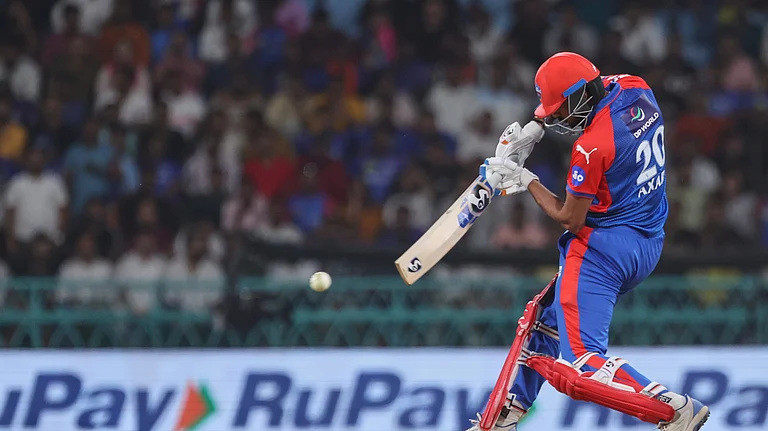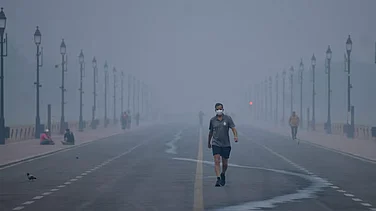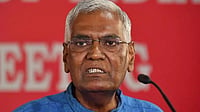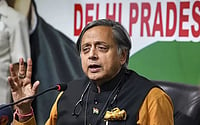IS incumbency likely to pose problems for Laloo Prasad Yadav? And will the BJP-Samata Party alliance be the beneficiary? These questions seemed irrelevant to the electorate in rural Bihar—that was the impression we gathered. But come to the urban centres like Patna and Ranchi and you will discover that the query is posed with unfailing regularity.
The incumbency factor has been reinforced in recent weeks by the Samata Party-BJP entente. More importantly, because the BJP, having won over 41 seats in the 1995 assembly elections, acquired a high profile in some urban constituencies. For instance, the party won three of the six seats in Patna. Likewise, Ranchi, Jamshedpur, Kishanganj, Katihar and Bhagalpur indicated a preference for saffron.
And because the BJP performed well after five years of Janata Dal rule, it was widely assumed that incumbency was impeding the juggernaut.
The question is, however, tinged with a degree of wishful thinking on the part of the urban-based upper castes. This is what we were told by some scholars at the prestigious A.N. Sinha Institute in Patna. Even though the BJP wrested two seats from the Janata Dal in 1995, these scholars do not recognise incumbency as a plausible explanation.
The explanation for the BJP's success lies elsewhere—in the post-Mandal churning process begun in the summer of 1990—and the sharp caste polarisation that took place in Uttar Pradesh and Bihar. In this scenario, the traditional upper caste support for the Congress defected to the BJP which, in months prior to the elections, was violently opposed to reservations for the backward castes in government jobs. This is the single most important factor which helped the BJP, though its appeal was still limited to only some urban constituencies.
Elsewhere in Bihar, Laloo Yadav improved his tally from 115 in 1991 to 165 in 1995. In other words, much more is being read into the BJP's limited electoral success than the facts indicate. Time and again, we were told not to draw our conclusions on the strength of the verdict of the relatively high-profile urban sectors.
Let us now turn to the Samata party's disengagement from the Janata Dal and its eventual attachment to the BJP. For one, the combination is engaged in an electoral combat for the first time so that they convey mixed and often confusing signals to their potential supporters. Second, in Bihar's exclusively caste-ridden parties, this entente cordiale does not reflect the complex social currents coming together. It represents, at best, simple caste arithmetic. Finally, the Samata Party leaders, chiefly Nitish Kumar and George Fernandes, have pinned their hopes on the Kurmis, the progressive and prosperous agricultural caste in central Bihar, notably in Patna, Nalanda and adjoining districts. They may find an important ally amongst the dominant Bhumihars who, in the absence of any organised caste formation of their own and the diminishing appeal of the Congress, may willy-nilly rally around the Samata Party to break Laloo Yadav's caste coalition. Yet, the strategy may not work. The party may pick up a few seats without being able to disturb the status quo. The Yadav-Muslim alliance, masterminded by the chief minister, has come to stay for some time and is most likely to erode the Samata-BJP combination. Laloo Yadav has, moreover, mobilised the Rajputs, many of whom are still tied to the Janata Dal and are loyal to V.P. Singh. In many constituencies Rajputs are pitted against the Samata Party candidates.
Nitish Kumar, the chief architect of the alliance with the BJP and representing the interests of the Kurmi agro-capitalists, has charisma but not much credibility. According to Dr Saibal Gupta of the Asian Development Research Institute, he is "yet to have a proclivity to be an organic leader of his caste/class. He feels shy even to be their organic intellectual."
Both in Patna and Ranchi there are mixed reactions to the BJP's electoral fortunes. One thing is clear. The RSS and the BJP have enlarged their support base in south Bihar since 1967 when their cadres earned much goodwill among the famine-stricken people of the region. Since then they have gained a foothold on the strength of their newly-created non-Christian Dalit constituencies. At the same time, they have incur red the wrath of the Christians and the Muslims.
In 1991, the BJP returned five candidates from the south Bihar constituencies. Three years later, Samata Party legislators broke away from the Janata Dal, and only eight of them returned to the Vidhan Sabha in the 1995 elections. In brief, the Samata-BJP combination is an untested one and their gains, jointly, are unlikely to exceed beyond four seats. So, if the BJP could win five seats, the alliance would not be able to send more than seven to nine MPs to Delhi.
So what accounts for the relative weakness of the BJP in Bihar as against Uttar Pradesh, where the party has gathered momentum in the aftermath of the Babri Masjid-Ram Janambhoomi agitation.
For one, Uttar Pradesh, the land of Aryavarta, has been the focal point of Hindu communal mobilisation from the last quarter of the 19th century. Not so Bihar. In addition, the communal tendencies in the state were weakened by the Kisan Sabhas and the socialist movement.
Professor Sachidanand, former director of the A.N. Sinha Institute, brought another important factor to our attention. The support base of the BJP in Uttar Pradesh, he pointed out, was drawn from the small and large urban-based trading communities—that is, the Aggarwals, Banias and Mittals in central and western Uttar Pradesh. These groups, with their ideological concerns anchored in the Hindutva traditions, are non-existent in Bihar.
Finally, everybody we spoke to commented on the limitation of the Congress movement in Bihar and its dominance by the Bhumihars and the Rajputs with their powerful landed interests.
That is why Sri Krishna Sinha, a Bhumihar, became the first chief minister after Independence. He was Jawaharlal Nehru's chief political ally. On the other hand, A.N. Sinha, a Rajput, was patronised by Rajendra Prasad, the first president of the Indian Republic.
Now, with caste-based alliances coming into play both at the centre and the state, it was not surprising that caste became a unit of political mobilisation in the localities. Consequently, there was little space for community-based politics. This is why the Hindutva ideology has not struck a favourable chord in Bihar, an otherwise volatile state.
In Uttar Pradesh, on the other hand, there were serious fissures in the Congress movement. A section was no doubt wedded to Nehru's vision of a secular and socialist society, but the Brahmin-dominated Congress leadership had different ideas. Thus, the consolidation of the Hindu vote started with Pandit Govind Ballabh Pant, its first chief minister. The Hindi agitation, as also the cow slaughter movement, was conducted under the aegis of the Congress. It is no coincidence that the Ram idol was placed in the Babri Masjid in 1949, with Pant still at the helm of affairs. Years later the shilanyas was performed under Congress auspices. In other words, the Congress on its own offered suffi-cient space to the BJP to organise its mobilisation campaign.
SCHOLARS and administrators alike dwell on the absence of land reforms in Bihar. This fact alone has enabled the Left movement, though weak and fragmented, to act as a bulwark against communal and revisionist trends. In Uttar Pradesh, by contrast, the CPI or CPI(M) have not made much headway. This is because their agenda was, to some extent, appropriated by the Congress (abolition of zamindari in 1954) and by non-Congress governments led by, notably, Charan Singh, The SVD and the Lok Dal forged cross-communal alliances, especially in western Uttar Pradesh, but it was not easy to either stem the communal tide or to erode the base of the Jan Sangh/BJP.
If the contrast between Uttar Pradesh and Bihar is real, how does one explain the recurrence of communal riots in Bihar? Clearly, one must not put the blame squarely on the BJP. After all, the Bhagalpur riots of 1984 took place with the Congress in power. An inept administration watched helplessly as 2,000 Muslims were murdered, their property looted or burnt down. Everyone we spoke to argued that the Bhagalpur riots constitute a watershed insofar as the Muslims, regardless of caste and class, abandoned the Congress. It symbolised said, Qazi Mujahidul Islam Qasimi, head of the Imarat-e-Shariah in Phulwari Sharif, the "parting of ways".
The Muslim disenchantment coincided with the grand swell of the backward caste, lower caste support for leaders carrying the Mandal banner, taking advantage of the enthusiasm and the hopes generated by V.P. Singh. Laloo Yadav forged, with dexterity, a solid Muslim-Yadav combination.
It was a year after the Bhagalpur riots that Laloo came to power in Patna with 115 seats. By 1995, he had dramatically improved his tally to 165 seats. And in the current parliamentary elections, the logical expectation is that Laloo will gain new ground or at least maintain the tally of the 1991 parliamentary elections.
To understand Laloo's appeal, one has to follow him on the campaign trail. There are no promises of major projects, what Nehru called the new temples of India, no unwrapping of a spectacular economic package. He comes across as a man-next-door from the village, who has cast himself as a wandering mendicant, one who beckons the poorest of the poor, the wretched of the earth to join hands and "march on Delhi" to "capture the Red Fort". He adds: "We have had enough tea at the Islampur street corner; let us now have tea in New Delhi's Connaught Place." In this conversational manner, without promising anything of substance, Laloo conjures up a vision of Bihar's poor inclusion in the governance of Delhi. The surprise is that this huge promise does not ring hollow when it comes from Laloo because he rattles off the list of communities who in the past had to keep their heads bowed in the village and who are now represented in the assembly, the legislative council and Parliament. His recent list of nominees to the council includes a Bind (earth digger), Tauti (weaver), Kumhar (potter), Lohar (blacksmith), Amat (landless labourer) and so on.
IN the past five years of Laloo's reign," comments Dr Saibal Gupta, "the most oppressed and suppressed have been imparted a new consciousness, confidence and social identity." A comparison with Mulayam Singh Yadav would be misplaced. The Samajwadi Party leader, insists Gupta, operates within the parameters set by Charan Singh's agrarian politics and is thus part of the "vernacular elite". Laloo starts from a base similar to Mulayam but reaches out to new, sometimes obscure groups at the lower extremity of the caste ladder—rat catchers, scavengers and worse off castes.
In this, Gupta finds a striking resemblance in Laloo's methodology of communication with Sagina Mahato, a celebrated celluloid character of the 1970's immortalised as an indomitable union leader by thespian Dilip Kumar. He makes intelligent use of his homespun nickname and refers to himself in the third person. "Darna mat; Laloo tumhare saath khara hua hai." (Don't be afraid, Laloo is with you).
By reaching out to an ever-increasing constituency beyond the pale, Laloo has invested his personality with a charisma of inexhaustible potential. His larger-than-life image has been able to cushion the animal husbandry scam. "It is an upper-caste plan to tarnish his image," murmurs Charan Das, a tea-stall owner in Jehanabad. "He is appealing to those on the fringes of the market or those outside the market," says Gupta. "This is a gigantic coalition of the dispossessed."
Secularism is another constant theme in Laloo's speeches: "Hindustan ke char sipahi: Hindu, Muslim, Sikh, Isai." (The four soldiers protecting Hindustan are Hindus, Muslims, Sikhs and Christians). "Muslims in the state are almost 100 per cent with Laloo," declares Qazi Mujahidul Islam Qasimi. This assessment probably leaves out the Muslims traditionally tied to the Congress or the various Left formations.
"What Laloo Prasadji has been able to ensure for us is the security of our lives and property," says Qazi M.O. Siddiqui, a minister in Laloo's cabinet. "Traditionally, secular Hindu leaders visited Muslims to console them or give them protection. Laloo is the first Hindu leader who reached out to the Hindu masses to convince them that the communal divide would weaken the cause of the poor," he adds.
Begum Abid Reza Bedar, a middle-class Muslim housewife in Patna, recalls the genesis of it: "We saw with our own eyes how
Laloo was always on the spot to control the riots that broke out after the fall of the Babri Masjid. And the self-respect he has given to the poor is something no Indian leader has been able to give the country's oppressed." Laloo travels either by a privately hired helicopter or by his "garib chetna rath". The consequent 'awakening' is a source of considerable anxiety even to the two communist parties. An influential communist leader said: "Just look at the leadership of the CPI and CPI(M) in the state. It is packed with the upper castes. If we do not mend our ways and the Laloo juggernaut is not checked, our cadres will desert us and join the Janata Dal."
For the BJP-Samata alliance Laloo's unorthodox methods of lower caste mobilisation present a frightful prospect. "He is the most corrupt politician the country has even known," bellows George Fernandes. Fernandes will probably win because the caste arithmetic in Nalanda—Kurmi, Koeri and Bhumihar—may be able to neutralise the Janata Dal caste alliance backed by Yadav militancy. This militancy is a very real factor in these elections. The Yadavs have been made to feel that their man is about to go to Delhi as prime minister (this is the refrain in all of Laloo's election meetings). Says Professor Sachidanand: "They feel that their caste pride is at stake."
When we asked Laloo if he planned to be "kingmaker or king", he laughed: "He who has the numbers will be heard. I expect to get 50 seats along with the Left allies." Obtaining 50 out 54 seats is absolute exaggeration and Laloo knows it. Yes, 40 seats is not unthinkable.
Laloo's projection of himself as a prime ministerial candidate is clearly designed to enhance his vote-catching ability. But this projection runs into minor difficul-ties in a constituency like Hajipur where Ram Bilas Paswan too is seen as prime ministerial material. "Supposing the LF-NF combine emerges as the largest single party, who else will join you to give you the majority?" we asked him. "The Congress will break," he said without batting an eyelid.
It is being whispered in political circles that Laloo may deliberately have fielded weak candidates against those Congressmen who would be inclined to join the LF-NF combine after the elections. For instance, Tariq Anwar, the Congress candidate from Katihar, is not expected to have difficulties against Mufti Mohammad Sayeed of the Janata Dal.
Even the suspicion that Laloo may be cultivating a core of pro-Janata Dal Congressmen has the potential of complicating the intra-Dal politics. Sayeed is, after all, a former president of the Janata Dal. In brief, the ever-expanding social base of Laloo Prasad Yadav will stand him in good stead in the current elections. Problems will surface later when intra-Janata Dal conflicts break out and when within his own state the newly awakened social groups begin to seek economic returns, an area where Laloo gives no evidence of being in possession of a blueprint.
At present there is hope in some circles that Laloo may fabricate a new class coalition with the same dexterity with which he has woven caste alliances. Indeed, a unique feature of the election is that for the first time after Independence, Bihar has an autonomous political agenda quite independent of the perception of national priorities.


























